Creating great social media campaigns may seem daunting.
We see the enterprise-level companies with deep pockets hitting the front pages of our favorite social networks. But how can a social marketer without the resources (or let’s be honest, time), compete?
Part of the beauty of social media is you don’t need a top-tier ad agency to run a great social media campaign. You don’t need a Scrooge McDuck room full of gold coins to compete.
What you need is a plan. That’s where this guide comes in.
We’ll cover what you need to do to create a social campaign that can compete, how you can track the impact of that campaign to look like a hero internally, and finish with some quick tips to jumpstart your strategy.
Now that you’ve explored your brainstorming resources and discovered topics of interest that will resonate with your audience, you can begin building out your creative social campaigns.
In this phase, you will strategically implement your most creative campaigns. This section provides you with five tips to ensure that your next social campaign is driven by creativity.
Social media presents a tremendous opportunity for anyone to share their experiences, expertise, and insight with the world. A large population of social users has been able to develop big followings that are engaged and eager to digest and share content.
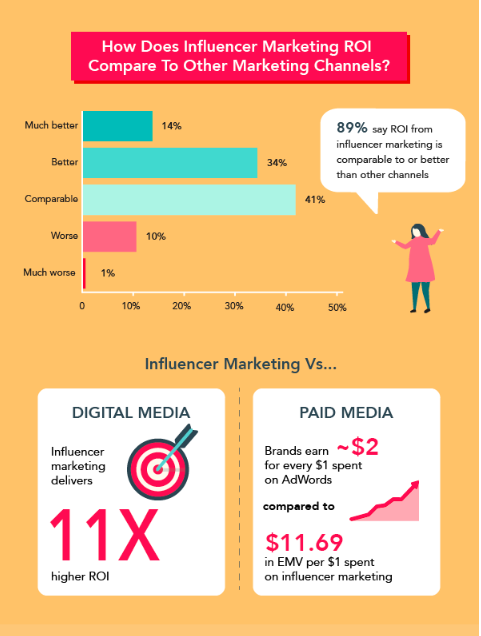
Marketers have been able to utilize these social media superstars to increase brand awareness, promote products and services, and use the digital word-of-mouth concept to build brand trust and increase sales.
Influencers also can be a great resource for you when you run into those creative roadblocks.
One of the great benefits of having influencers in your social strategy is that they are already master content creators. They’ve been able to build their followings based on the engaging content they share on social. Their videos, pictures, tweets, and posts receive high levels of engagement.
Influencers will produce unique content for your brand, with a fresh perspective–a huge benefit for your brand if you feel you are lacking creative content.
Their social audiences already seek their advice, and influencers greatly impact purchase behaviors. In fact, 50% of consumers made a purchase based on a general recommendation made on social media, according to TWP Inc. Influencer-generated content can bring creativity back into your social strategy, and will require minimal effort on your end.
Wayfair, a furniture retailer, utilizes user-generated content in their social strategy. They share user images with links to shop for products within their posts, making it easy for consumers to visualize products in their own home for design inspiration, combined with the customer testimonial effect of actual users sharing their purchases. Wayfair simply had to repost content– minimal effort for a huge social impact.
If you are running out of ideas to keep your social strategies creatively fresh, turning to your competitors is a practical way to develop creative content.
Be careful not to mimic the content of your competitors, but use their social strategies for inspiration. Your brand and its competitors have similar ideal customer personas, so focus on the type of content that is most engaging, both within your own social efforts and those of the competition.
Not every piece of content you produce is going to perform well with all members of your target audience in every stage of the sales funnel. If you find yourself lacking the inspiration to produce creative social content, shift your focus to create content specific to where your customers are in their buying journey.

In the awareness stage, your goal is to increase the number of people who know about your brand, its services, and its offerings. The content you produce within this stage needs to be eye-catching but doesn’t necessarily have to speak directly to what your brand has to offer. The focus here is to grab your audience’s attention. There are a few ways you can do this:
Use Images
Posts that include images produce 650 percent higher engagement than text-only posts, according to WebDAM. Using the right visuals in your social media posts is essential to catching the attention of an audience who rapidly moves through social content. Visuals are both memorable and effective. Your audience can process, understand, and retain more information more quickly.
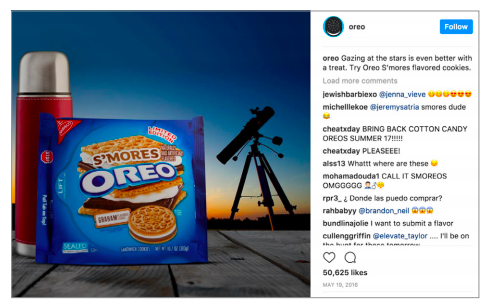
Oreo does a great job on social by combining their product with visuals that provoke emotional reactions. Their post promoting their new S’mores Oreos places their product next to a thermos and a telescope, which creates a sense of wonder with reference to exploring the wilderness and the unknown.
Save some time and energy by sharing content that your followers create. Initiate engagement by proactively sharing content that can positively promote your brand, while also boosting the ego of your audience. And, let’s face it, we all could use a little ego boost from time to time. Your audience will be delighted by your brand sharing their content and will be excited to share the news with their followers. It’s a win-win situation.
Starbucks often posts user-generated content to their social profiles, and typically sees a lot of engagement from its followers. Starbucks asked its followers on Instagram to share their cozy moments with the limited Starbucks Red Cup. This single post featuring a Red Cup and comfy blankets received nearly 300,000 likes and collected over 400 comments.

The beauty of social media is that it allows for a two-way dialogue between your brand and its followers.
Ask your audience questions, take a poll, or comment on their posts and engage in conversations they are already having on social. The more active you are on social media, the greater your chances are of increasing your brand awareness. Consistent interaction with your followers will be a fruitful addition to your overall social strategy.
Social media went into hyperdrive when users couldn’t figure out if a dress was black and blue, or gold and white. Specsavers took advantage of this trending conversation on social to promote their business and have people come in for eye checks. This particular tweet was retweeted over 12,000 times and received over 8,000 likes.

In the consideration phase, you start providing content that is a bit more specific to your brand and its offerings. You want to entice your audience to want to learn more about your business. Here is where you would provide small chunks of information regarding your brand.
It is imperative that you use social media to drive traffic back to your website or your blog during the consideration phase. Your website is a hub for all information related to your brand and your offerings. Your brand’s website and blog can even provide e-books and white papers to learn more.
IKEA was able to use user-generated content to drive people back to their website. IKEA highlights the stylish designs of their followers and includes a shortened link to their Share Space page on their website, where happy customers share their design inspirations and showcase furniture in their own homes.
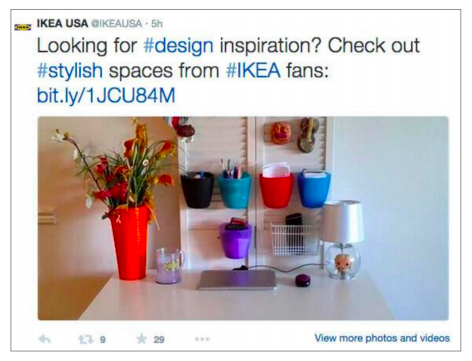
Your brand loyalists will often share positive reviews of your brand on social. Utilize those customer testimonials to tell a story on your own social profiles. During the consideration phase, your customers are seeking input from other customers that will ultimately influence their purchasing decisions. 92% of people trust recommendations from individuals–even if they don’t know them–over brands, according to TWP Inc.
Myers + Chang, a restaurant in Boston, Massachusetts, retweeted a post from a happy customer. Sharing testimonials increases brand trust and allows your users to tell others how amazing your business is, saving you the trouble of having to tell them yourself.
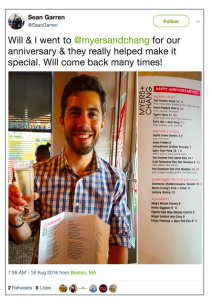
Your followers on social may often want to interact with you online. They may just be giving your brand a shout-out on social, but may also have concerns or suggestions for your brand. Don’t be afraid to interact with your followers by responding to their questions or thanking them for the mentions. A study from Nielsen found that 33% of customers prefer to contact brands using social media rather than on the telephone.
PinkBlush, an online maternity retailer, responds to questions that their followers have on Facebook. In this particular post, a customer asks how fast PinkBlush can ship to New Jersey. PinkBlush responded directly to that customer and provided a link back to their website to learn more information and to complete their purchase.
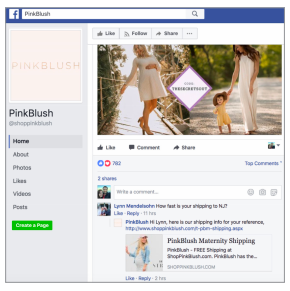
During the intent phase, your customer is at the brink of making a purchasing decision. According to Forbes, 78% of respondents said that companies’ social media posts impact their purchases.
This is your opportunity to hit them with relevant content on social media to influence their decision in favor of your brand. Provide a Demo or Special Offer In a survey by Knowledge Networks PDI, 58 percent of nearly 1,800 respondents said they would buy a product after trying it.
Demoing your product on social media or giving your users exclusive offers will have a huge impact on your conversion rates. Your goal here is to provide an incentive for your followers to make an actual purchase.

In their profile, Dollar Shave Club provides a link where their followers are redirected to their website to sign up for their subscription and have shaving supplies shipped directly to their door. Saturate your profile, even the bio section, with ways for your customers to make easy purchases.
In the conversion phase of the funnel, you’ve successfully guided your customer to make a purchase. At this stage, you can now shift your social strategy to create brand advocates, or influencers, for your brand. The type of content created should be shareable content that your followers can deliver to their own followings, to guide more leads into the top of your funnel.
After making a purchase online, provide an option for your users to share their purchases with their followings. This will increase brand awareness and influence potential customers, and it requires minimal effort. Give your customers the opportunity to brag about your brand.
Here we go again talking about user-generated content, and that’s because user-generated content is so important for a successful social media strategy.
During the conversion phase, you have the great opportunity to turn all of your followers into brand advocates by having them create content for your brand. National Geographic, for instance, asked users to submit photos for a chance to win a trip to the Galapagos Islands. National Geographic even hosted all submissions on their website, with sharing options at the bottom of each submission, making sharing on social easy for their visitors.
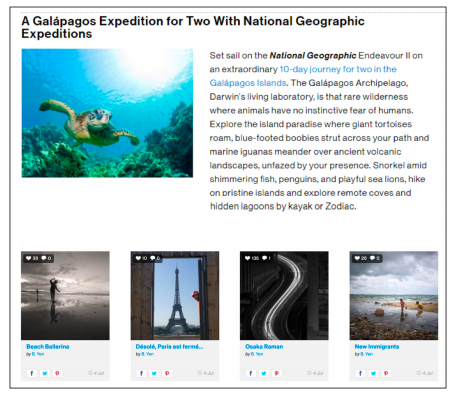
Still at a loss for what kind of content to create for your social media campaign? Here’s a little cheat sheet about the social posts that encourage consumer likes and shares.
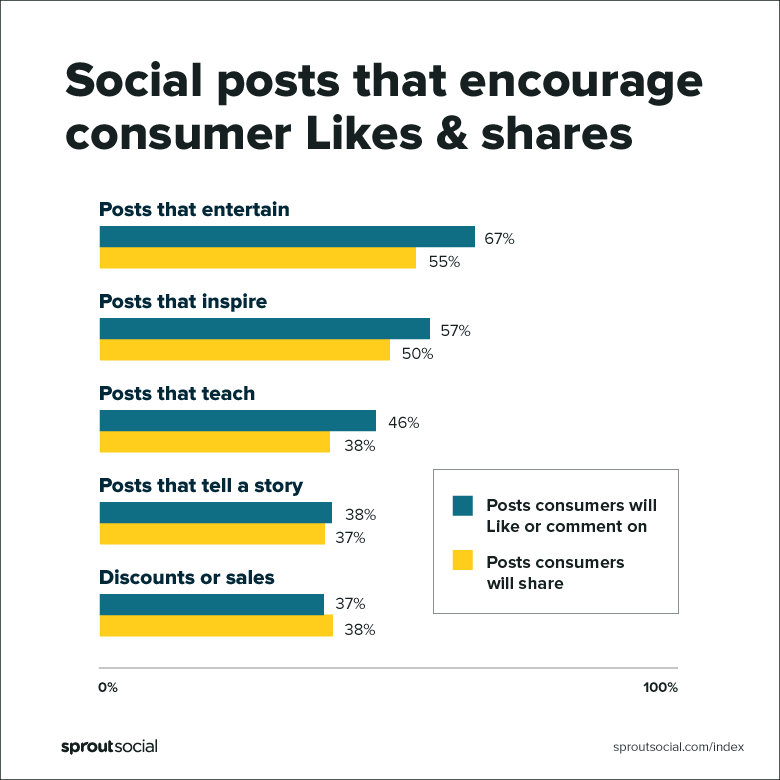
By this point in your social strategy planning, you’ve already brainstormed innovative ways to boost brand awareness and engagement on social, and you have implemented a plan that targets users at each stage of the sales funnel, with specific content based on their buyer journey.
Now it’s time to analyze your campaigns to guide the creative process going into your next social strategy planning cycle.
Metrics matter. Choosing the appropriate metrics to track and analyze is vital to properly gauge the success of your social media campaigns. With the tremendous amount of social data now available, be sure to choose metrics that align with your objectives.
When it comes to your content, engagement metrics provide the best type of data to determine the overall likeability and effectiveness of your content pieces.
Engagement tracks the number of unique people who have clicked, liked, commented on, or shared your posts. Engagement metrics provide insight into how your content is circulating around the social sphere. Your most popular content is going to be liked more, shared more, and commented on more often. There are three engagement metrics that are universal among the major social networks:
In the analysis phase, there are two action steps you can take to gauge the effectiveness of your social marketing efforts:
Social media is making a huge impact on overall marketing strategies. Refer back to your social listening and content share tracking solutions to gauge the effectiveness of your social strategies.
Analytics solutions can guide you through specific pathways to discover challenge areas or gaps in your social strategy, and can help identify areas where your social marketing efforts are most rewarded. You also are provided insight on audience engagement, reach, and impressions.
Social listening solutions make campaign tracking a breeze. By setting up queries to listen across all of social for posts indicating your campaign, you not only see the reach and engagement, but you can see the general sentiment as well.
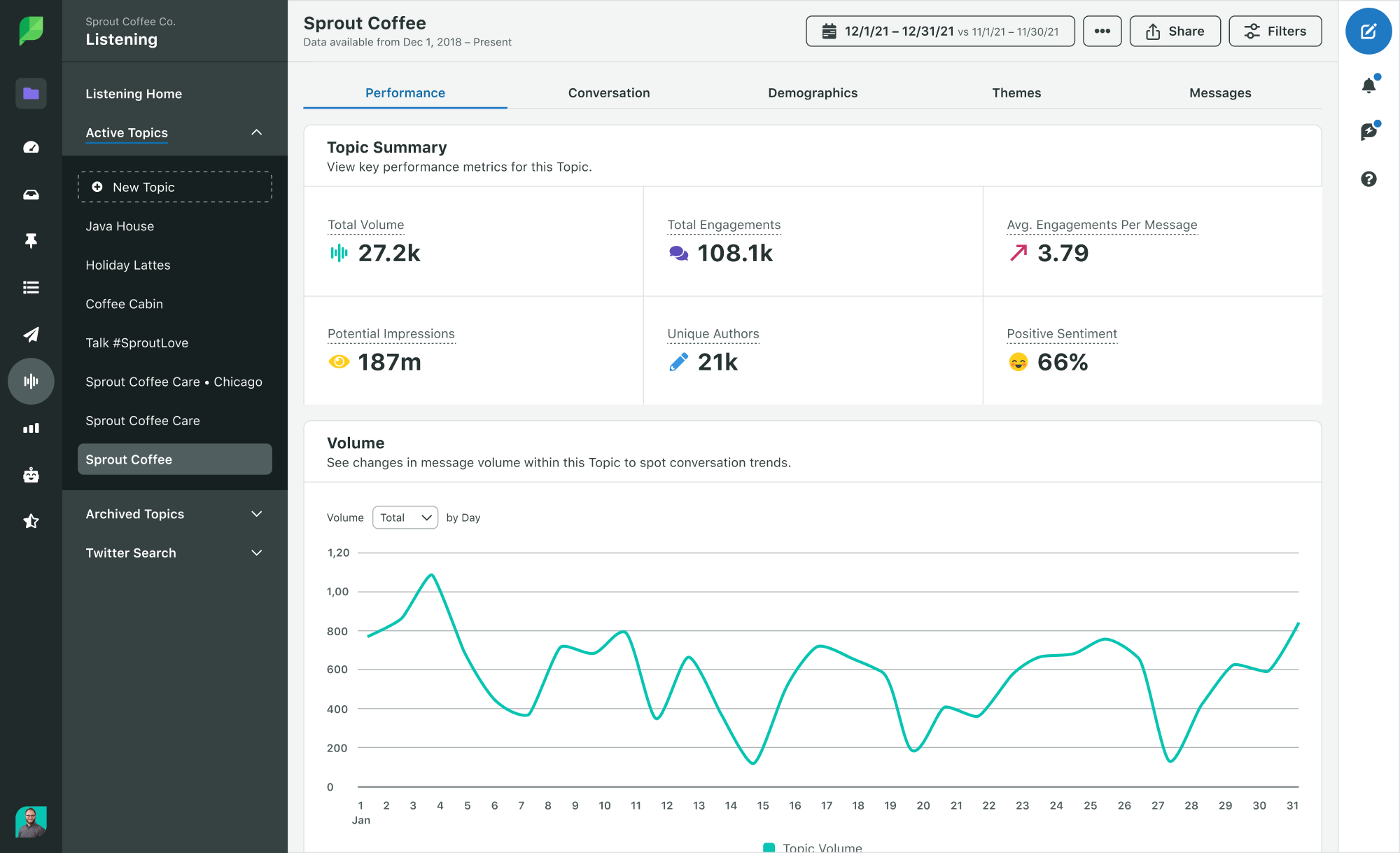
Another simple yet powerful way to track campaign success is using social media tagging. This is something you’ll need a social media management platform to use, but this tool alone makes it worth it.
Create a unique campaign tag for each of your campaigns and whenever you publish a message using that tag. Additionally, tag every inbound message with the same tag to ensure nothing slips between the cracks.
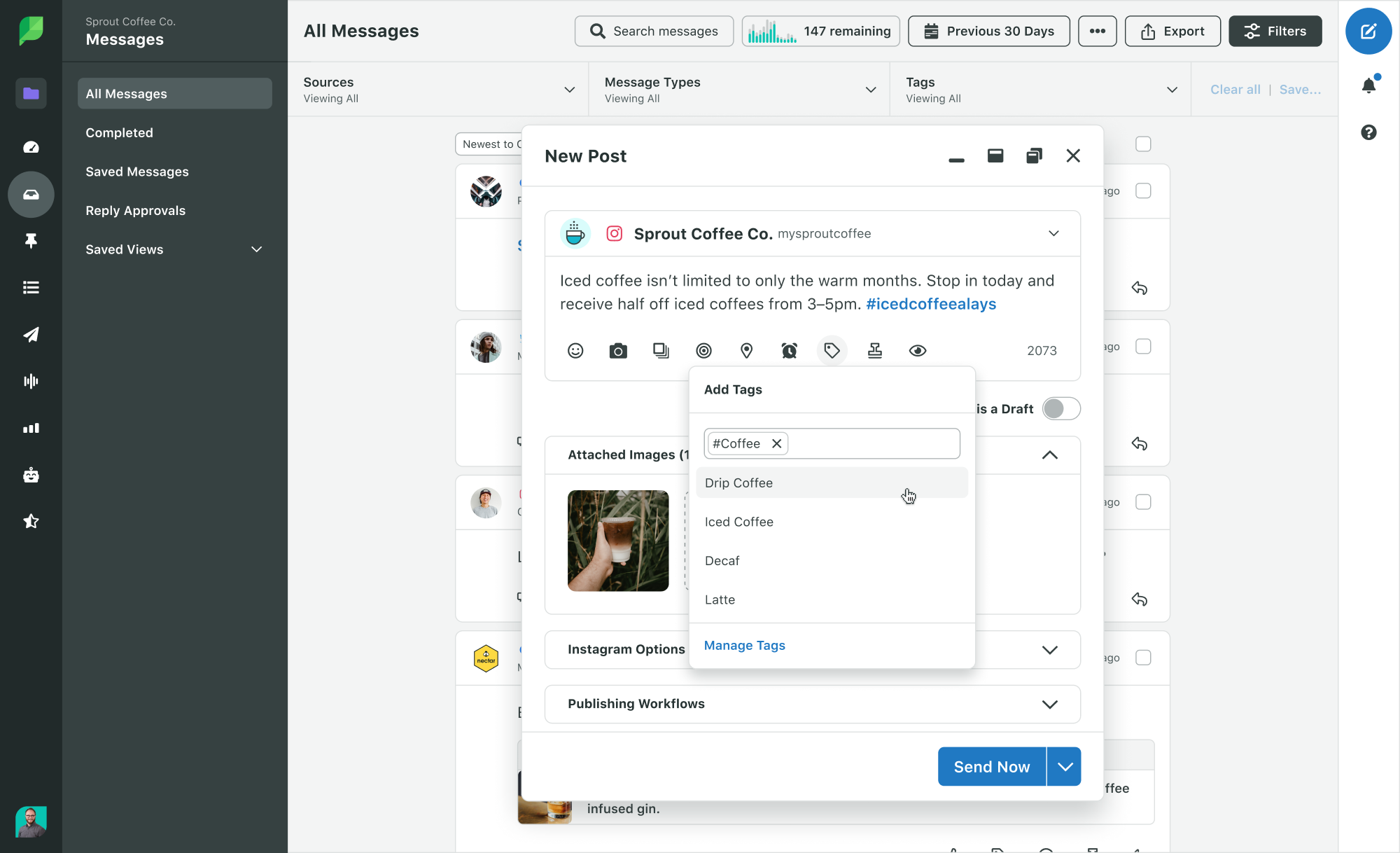
You can immediately start looking at your social media tag report to see the performance of your campaign across all profiles and social networks.
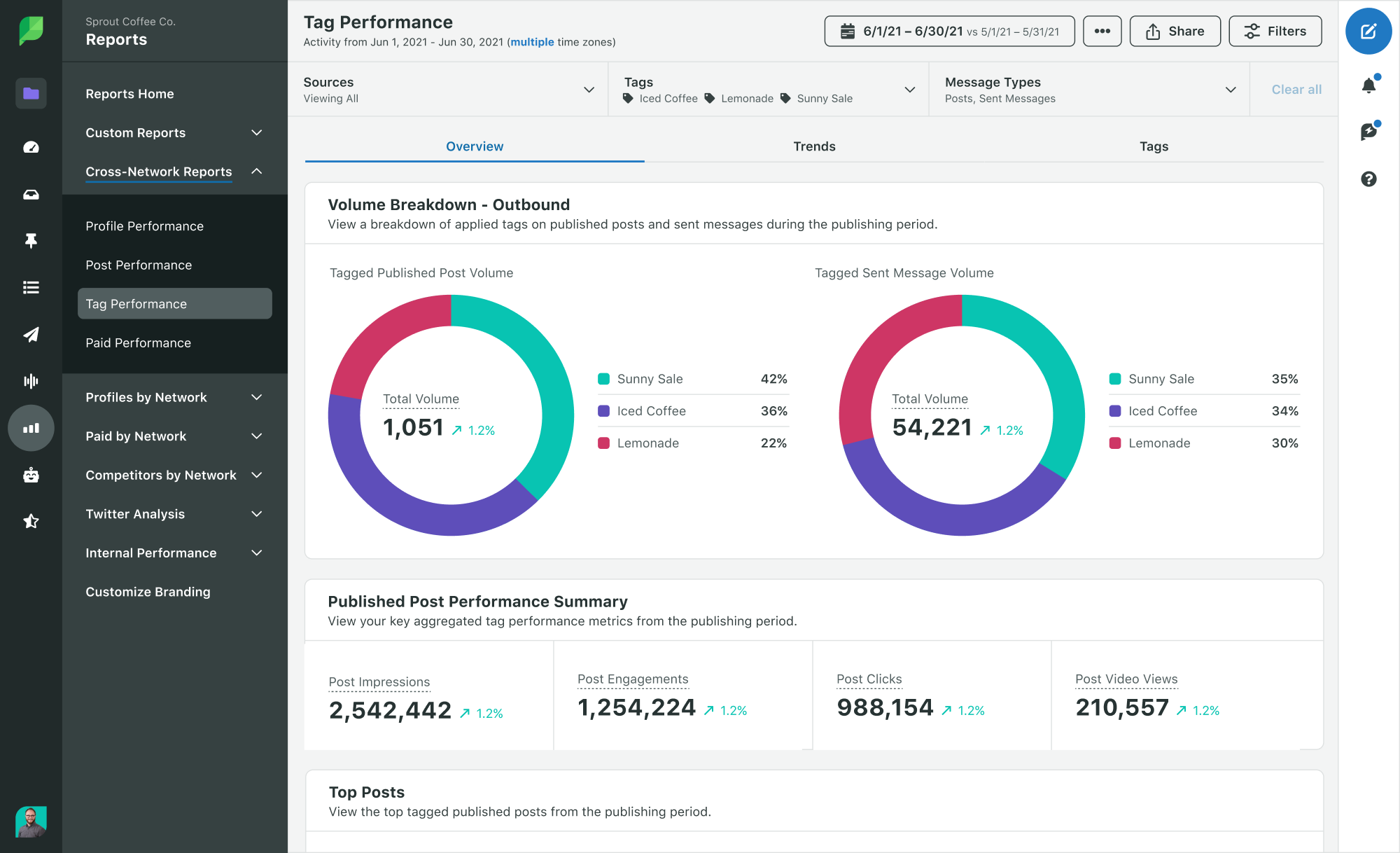
With this, you can see data like:
Listening to your friends comes naturally. You want to hear what they have to say, and it’s easy: they’re sitting across the table from you at brunch, or you’re texting up a storm, back and forth.
Because you are involved in this seamless interchange of information, and listening intently, you know as much about many of your friends as you do about yourself.
The same is not true of your relationship with your social audience.
With our social audiences, we tend to push out information (owned content) and measure the effect of that content. Sometimes we forget to begin by listening to our audiences and building content around what they actually care about.
We end up pushing out content that just isn’t quite right. It’s like your friend telling you about a Golden Retriever puppy she wants to adopt and asking for your advice, and you responding by listing out your favorite qualities of Labradoodles. Tangentially related, but not quite right. We marketers fall into this trap an awful lot.
Here’s how you can begin to shift your thinking.
Building empathy happens when you pay attention and listen deeply. This tends to come naturally in friendships: if your friend is hurting, you’re hurting. You wouldn’t scroll through your Instagram feed while your friend shared the painful news of his divorce, would you?
The same concept can be applied to your relationship with your customers and/or social audience. Don’t busy yourself so much with your owned content (what your brand has to say) that you miss out on what your audience is saying and feeling on social, forums, and blogs.
By building a solid foundation of empathy for your audience’s wants and needs–and how those wants and needs evolve throughout the customer journey–you’re also building better content, responses, and, ultimately, sentiment around your brand.
One reason you’re able to so easily understand your closest friends is that you have a shared history. You’ve heard the story about Johnny chipping his tooth on a parmesan rind back in college a million times. You were there when Linda got to party with Snoop Dogg on her bachelorette trip.
The same level of historical knowledge is important when it comes to your customers. That’s why a social media tool with a CRM is critical.
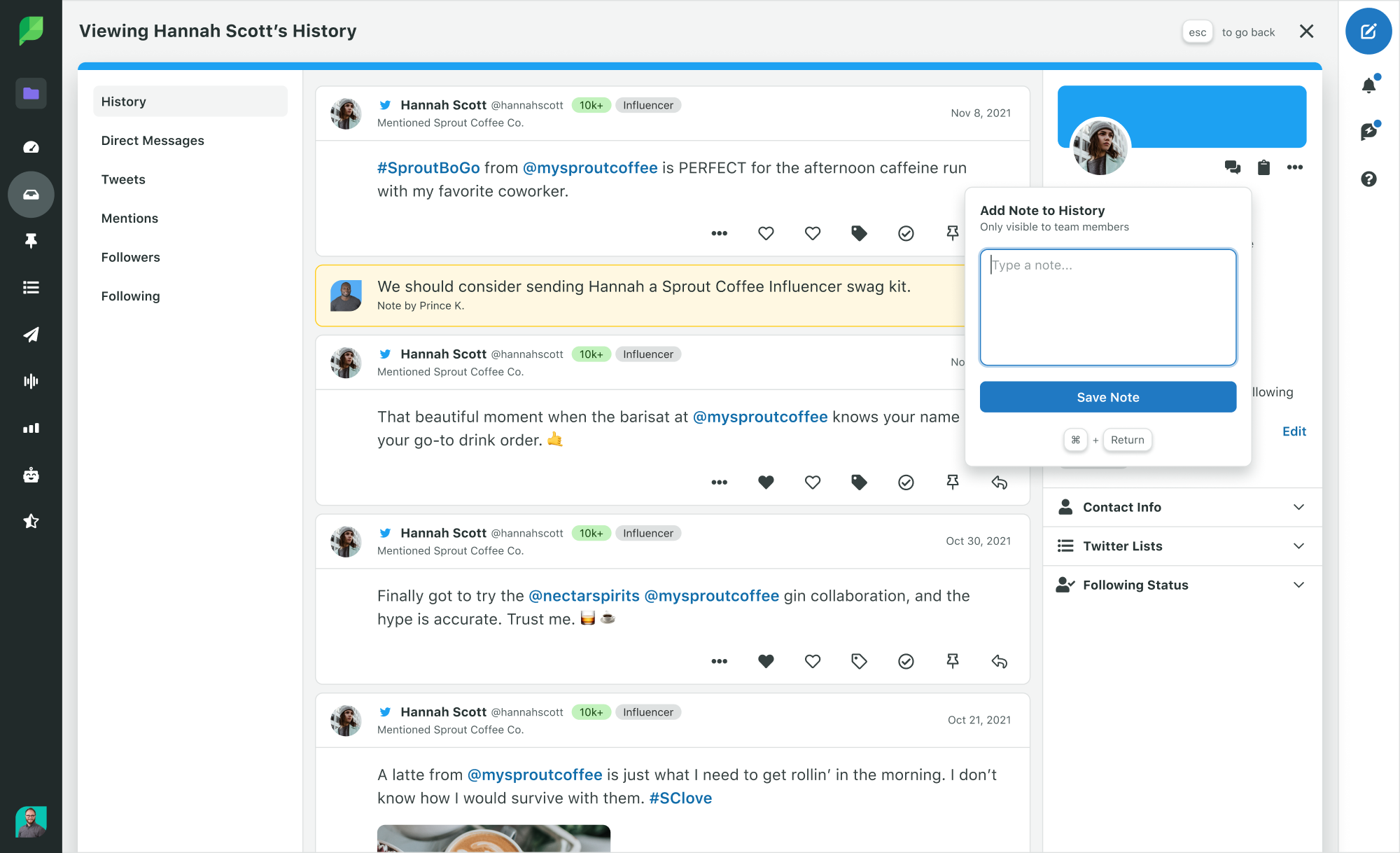
When has your brand experienced the greatest spikes in reach, engagement, and volume? Which tactics and channels have historically worked for you (or your competition), and which have been misses?
This is another common mistake for marketers: we commit to a campaign, regard it as a success or failure, and then move on too quickly to learn and document valuable lessons that can help us do better in the future.
Don’t fall into this trap! Continue adding to your (separate) lists of customer knowledge and self-knowledge regularly as time passes and the data keeps rolling in.
You and your best friend have an endless assortment of inside jokes and maybe even made-up words and phrases that only you two understand. It’s kind of annoying, TBH. But shared experience = shared language.
The same equation is true for listening to your customers on social. If you understand the slang and solutions that your audience throws at one another without you hovering in the room, you’ll eventually be able to learn their language and use it to better reach them.
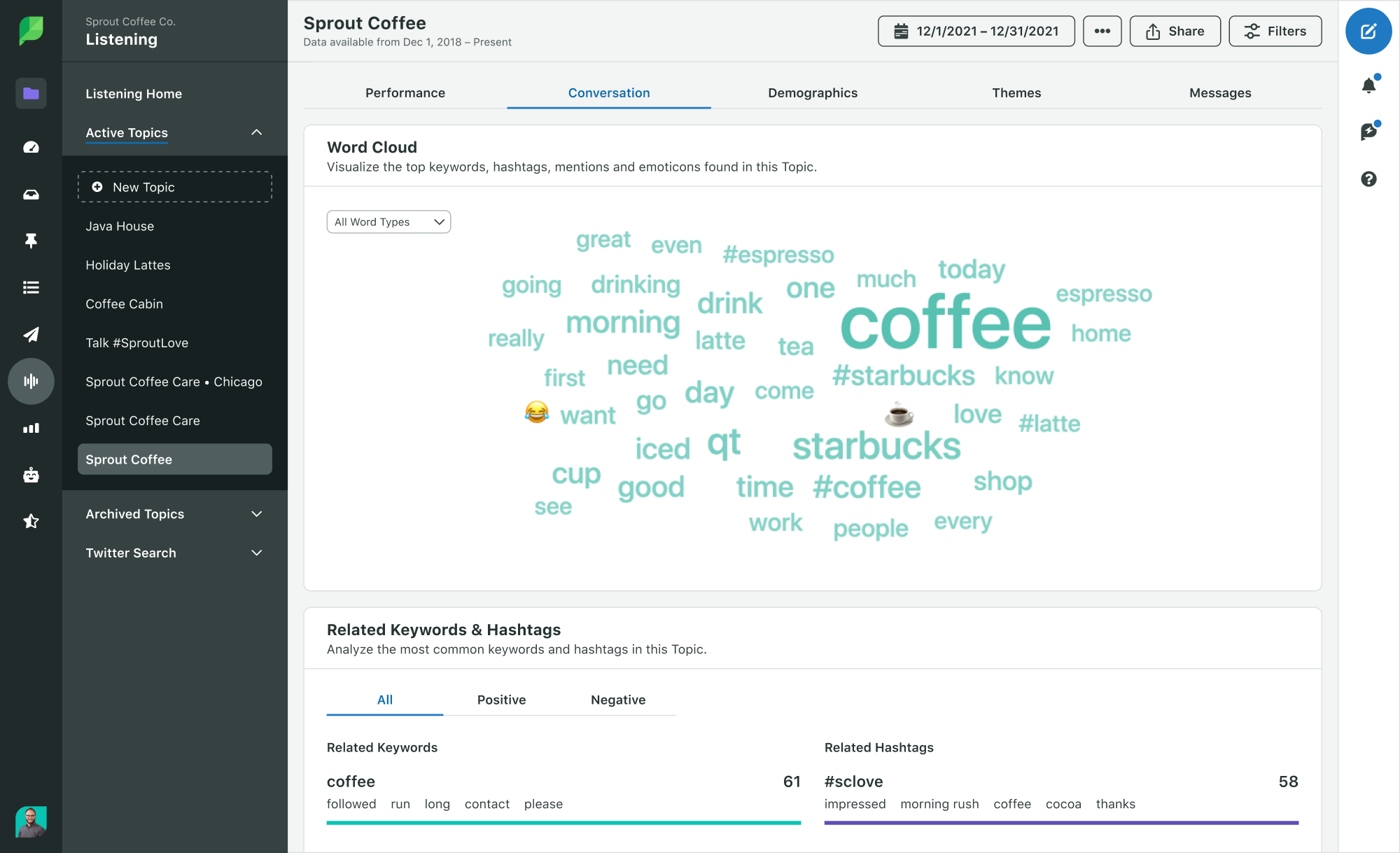
As you grow up, you stop making time for friends who don’t give you the same level of attention as you give them. This can also be applied to your social media program. Understand how your audience prioritizes you, and you’ll be able to adjust your brand’s behavior accordingly.
This doesn’t mean that you’re going to stop targeting customers or potential customers who like another brand over your brand. But it does mean that you might go more aggressively after one customer segment and veer away from another, or that you might spend more time doing competitive campaigning against one particular brand on social. The only way you’ll be able to prioritize correctly is by understanding where you sit in relationship to competitors in your (target) audience’s eyes.
The best conversations with your friends happen after a glass of wine or two, when you go deep into your fears and hopes and vulnerabilities. Don’t miss out on the most important, in-depth information about your customers by staying on the surface.
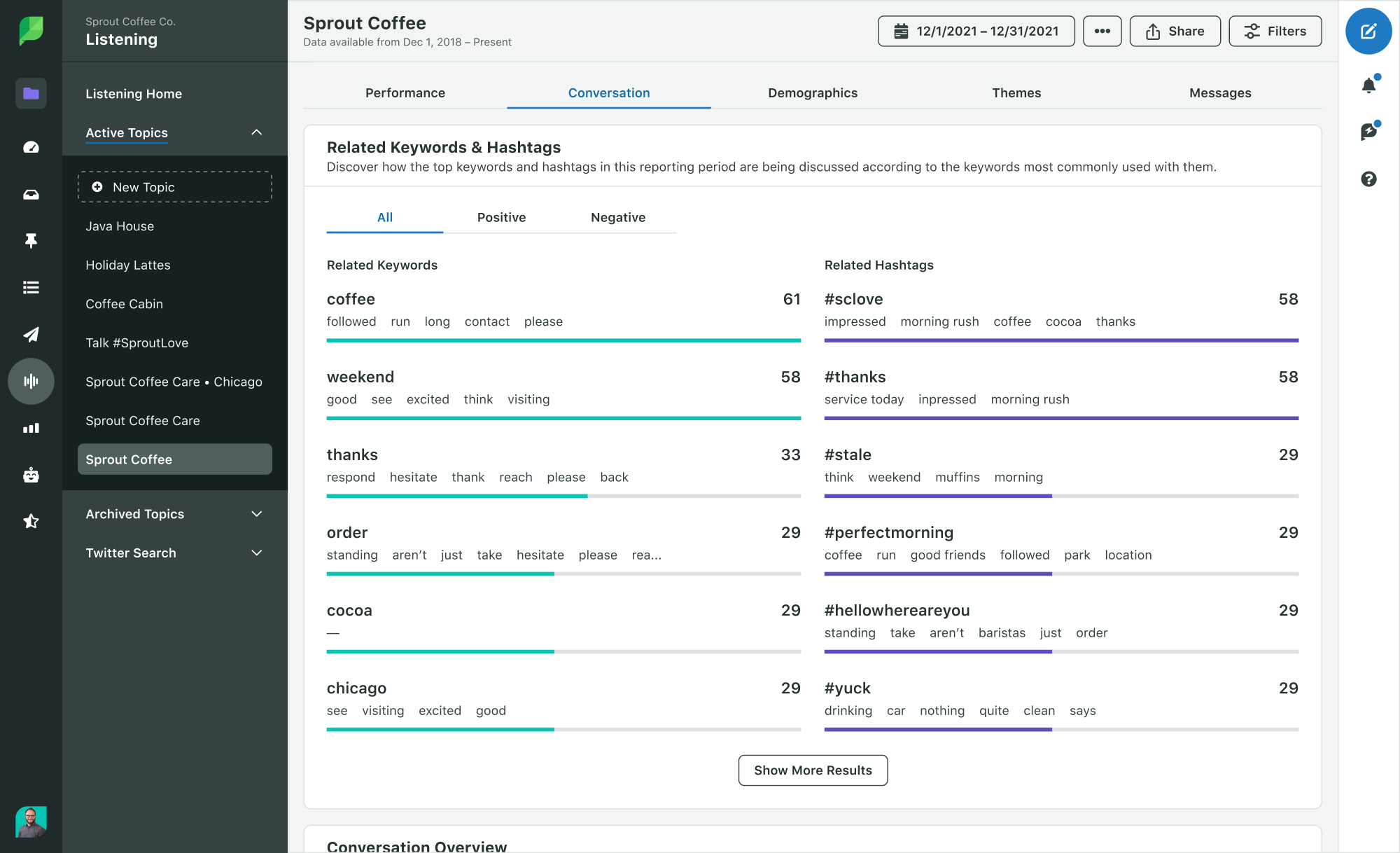
Take the time to look at the most buzz-generating comments around your brand and/or industry on social at least once a day. This will give you the level of depth you need to move forward and make better choices.
Take a marketer you know and admire out to lunch, or approach him or her on social and ask for a quick chat. Come prepared with a set of questions, as specific as possible. We recommend choosing a particular campaign you were floored by, and digging deep to find out what you can learn for your own brand.
We have some social media experts on our staff who are always happy to talk about how Sprout Social’s full suite of social media tools can help you leverage data to come up with new campaign ideas.
This may take the form of jumping on a call or running a survey, depending on your business. However you consume this feedback, know that it is one of the most important things you can do to understand how people who give you money actually think and feel about not only your product but your industry at large.
If you’re not in a position where you can talk to your customers directly, try and schedule some time with your customer success team. These are the folks who have consistent conversations with your audience and can tell you exactly what pain-points they’re looking to solve. Then you can create custom social media campaign strategies catered to those specific challenges.
Doing your research on how marketing executives (including your own!) think and operate is essential. Read interviews with CMO’s from best-in-class brands, and pay attention to the initiatives being emphasized on a broader level at your company.
The strategies and messaging set at a high level always impact what marching orders are departmentally–if not now, next quarter. Understand bold, innovative visions and you’ll be able to come up with and execute creative campaigns that accomplish business goals in your organization.
Some of the best creative ideas you’ll find for social media campaigns come from outside business.
Here are some of our favorite quotes from thinkers who focus on expanding creativity and self-improvement. We recommend reading these books when your well has run dry.
Being able to pivot quickly according to data findings is important. No one believes this more than us.
But abandoning a campaign or messaging angle or visual approach because the data doesn’t match your ambitious goals within the first week or month is not the smart way to go, because it doesn’t give your message enough time to saturate the market, if it is going to saturate the market.
By pivoting too quickly, you risk diluting your brand story and recognition with too many different messages within too short a time span. This confuses your audience and ultimately gives your competitors an advantage.
We recommend making no campaign less than three months long, and breaking your campaign plan into multiple phases. At the end of each phase should be a stopping point at which you formally evaluate the data, and come up with an action plan for modifying your plan accordingly.
Both Cadillac and AirBnB have done an excellent job of addressing 2017’s divisive political climate in a way that:
This is a tricky balance to strike, since by addressing political themes brands often experience blowback. It’s not a good strategy for every brand. Before putting together a campaign around this, do four things:
If you’re interested in getting political on social, check out our recent data study on the impact of taking a stance on social. Below are the key findings:
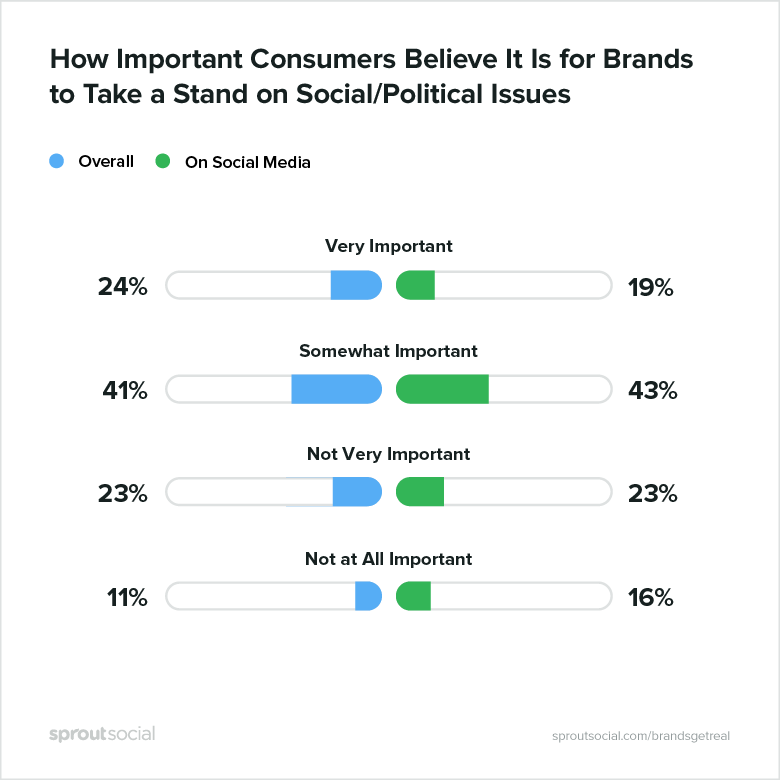
Wikipdia defines the Mozart Effect as:
“A set of research results indicating that listening to Mozart‘s music may induce a short-term improvement on the performance of certain kinds of mental tasks known as “spatial-temporal reasoning”.
So try and listen to some music while working on your social campaigns! Use Spotify to create a playlist that goes along with your campaign, and encourage followers to share the playlist on social for a chance to win a prize.
Do your social and content teams work closely enough together, or do you run on parallel tracks that rarely intersect? If the latter is true, you’re missing out.

When your content team is regularly informed about what’s performing well (or not) on social, they can create better content for your social team. When your social team is regularly updated about which content requires promotion to fit brand messaging, product offerings, and larger marketing initiatives, they can be more strategic about how they post. Magic can really happen in this intersection.
Once you have a clear campaign theme and message that your entire marketing team is driving toward, your email marketing team begins planning sends. Make sure you’re aligned on these sends so you can figure out how to best support the larger campaign by driving web visits and content downloads.
If you’re not involved in these meetings now, you should push to be. Previously unexplored collaboration opportunities can make great ideas happen.
What you do on social plays a role at every point in the buyer’s journey – all the way from awareness to decision. Own that powerfully this year, and fill the gap between awareness and decision.
Content share and conversion tracking are useful for leveraging public and private social sharing signals from real customers and prospects to provide you with the insights you need to increase traffic, leads, and revenue by producing and distributing content that drives conversion. This allows you to:
Looking into what campaigns have a tangible impact on your bottom line may help you discover campaigns that will drive amazing results.
Regular competitive analysis helps you create benchmarks for your own brand. For instance:
Remember that the brands you benchmark against don’t necessarily have to be competitors for dollars in the bank, or even within your industry: they can be competitors for a certain brand voice or visual association you are trying to foster with your target audience.
Your target audience only has so many hours in the day to interact with brands on their social feeds; you want to make sure your brand is front and center, and, if it’s not, understand why.
If this is a new concept to you, check out our guide on running a competitive analysis on social media!
I’m talking Snapchat and Instagram Stories here, people. These platforms give you creative freedom as a brand, and a chance to infuse your brand with personality in the public eye, increasing brand advocacy and conversions.
Invest time and resources in Instagram Stories (which can be great conversion points from Instagram), Snapchat, and/or Facebook Live. Do your research on brands incorporating these platforms in their campaigns already, and you’ll find inspiration.
We all have a circle of influence, but we may only be influential about certain topics. The same is true when it comes to social media, and identifying the people who hold esteem in specific areas can be a challenging task. Influence boils down to three key factors:
The quickest place to start is by looking at the influential folks who are already engaging with your content and talking about your brand.
We have a mantra on our marketing team that “the answer isn’t in the building.”
This mantra pushes us to validate assumptions by listening to actual humans. This is good advice for anyone looking to identify influencers on social media.
Don’t just look for the folks who are tagging your brand in every post and already engaging with all of your content (although, as I mentioned above, you may find some valid opportunities there as well). Look for folks who are driving value in conversations that are relevant to your brand, but not ones that necessarily involve your brand.
With Sprout’s Social Listening, discover the most influential and engaged people discussing any topic of your choosing.
British Airways recently did this with panache. Their #Unforgettable campaign, devised by Ogilvy & Mather, recruited a father and son after they wrote a review thanking British Airways for their New York trip.
The centerpiece of the campaign was a video, which was complemented by a social media competition inviting people to share their #unforgettable holiday moments, geniusly soliciting UGC from a content piece with its roots in UGC.
Can you think of any brands that would make good partners during your next social media campaign? These should be brands that:
Co-marketing is a great way to expand your awareness with people likely to buy your product.
These should be two different tracks in your social media marketing strategy.
On the one hand, you’re trying to keep and engage with the customers you already have. On the other hand, you want to, obviously, acquire more customers, AKA ROI, with your social strategy. Some content might appeal to both customers and non-customers, but you should also be creating unique strategies to target each of these categories.
In your content calendar, make sure you should have posts and mini-campaigns devoted to each of these categories.
This applies if your brand targets young folks, has a brick-and-mortar presence, a pop-up shop, and/or is sponsoring a booth at a conference.
A recent study by Accenture examines the attitudes and expectations of 18- to 20-year old Gen Z consumers–those already with spending power–along the path to purchase and compares them to Millennials. The study is based on a survey of nearly 10,000 consumers across 13 countries, including 750 U.S. consumers.
While Gen Z is very much a “digital native” group, 77% still prefer to purchase in-store. In addition, 44% will go to a store to get more information before making an online purchase.
For awareness-generating campaigns, your social strategy doesn’t have to be as micro-focused on your value prop and brand as you think. Once you know who your audience is on social, you can build campaigns that appeal to other aspects of their lives and perspectives.
For instance, you might be a hotel chain hyper-focused on medium-budget travelers between the ages of 21-30. You could create a whole campaign around budgeting for travel. The most important thing to remember here is that you need to provide value that is totally unrelated to closing a deal: this is an engagement-generating campaign to push people further down the path to purchase, not get them to book with you immediately.
With a campaign of this nature, if people feel they are being blatantly sold to, they will automatically distrust the content you’re surfacing.
There are countless studies and stats being released about how social media affects the human brain, and how different demographics engage on social. Read ‘em! These studies give you insight into how people interact with social in general and, ultimately, your brand.
Chances are, the words and terms you want to rank for as a brand on Google are the same that you want to be associated with on social. Contact your SEO friend in your organization to find out which words and terms you are focused on, and weave these into your social media campaign strategies. This is especially important as Tweets are now included in Google search results for certain words and terms.
And create follow-up content to make the most of your efforts there. This follow-up content should direct people towards your blog and/or website.
Don’t jump on the #Oscars2019 hashtag if you’re a B2B analytics company. With such a buzz-generating, business-irrelevant event, you’re not going to reap any tangible rewards for your business.
The customer journey is your new marketing funnel. The social media marketer’s job is to move people through the customer journey via social media sharing: from awareness to consideration, to purchase, to the loyalty and advocacy stages. Make sure you know how your content is being shared across this journey, and across all your active social channels.
This is not a copout tip. Exercise:
If you’re sitting at your desk, truly in a creative rut, go take a walk, a run, or a yoga class. Shake it out. Then keep mulling our tips over and put together your Best. Campaign. Ever.
Creativity can sometimes be scarce, but there are actionable things marketers can do to maintain a creative outlook on their social marketing strategies.
In this guide, we provided you with brainstorming resources to guide your social strategy into a more creative direction. When you run into a creative roadblock, you can attend webinars, engage on forums, subscribe to newsletters, and use social analytics solutions to determine audience interests and best-performing posts. This insight will guide your creative process.
As you build out your social strategy, utilize your influencers to create unique content for your brand and increase brand awareness. Listen to your audience to join relevant conversations already happening on social, and to guide your future social strategy. Compare your efforts with those of your competitors, track your content’s performance on social, and adjust your content to align with the user at every stage of the sales funnel.
Analyze your efforts by determining your success metrics and use social analytics solutions to gain insight into the effectiveness of your social campaigns. The data will guide your future strategies as you jump into your next creative cycle and launch your next social campaign.
Looking for a social media tool to help you plan, execute and analyze all your social campaigns? Start your own free trial of Sprout today and get to planning.
Social media campaigns by network
The most successful social media campaigns span multiple networks simultaneously. Some even incorporate other media channels like TV or radio.
But if you’re looking for a specific social network to create campaigns for, we have content for that as well.